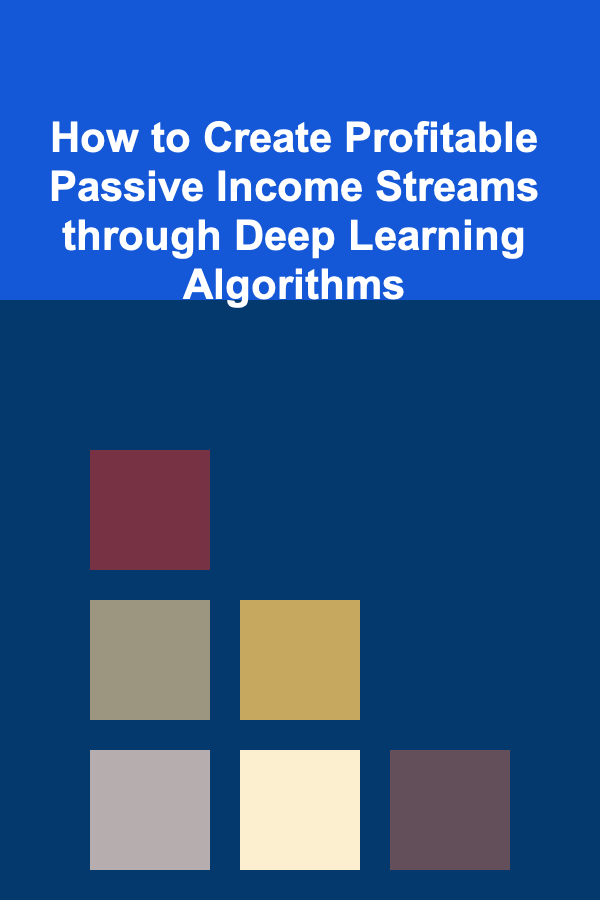
How to Create Profitable Passive Income Streams through Deep Learning Algorithms
ebook include PDF & Audio bundle (Micro Guide)
$12.99$6.99
Limited Time Offer! Order within the next:

Deep learning, a subset of artificial intelligence (AI), has rapidly become one of the most influential technologies in the modern world. From powering self-driving cars to enabling sophisticated recommendation systems, the reach of deep learning spans numerous industries. What makes deep learning particularly exciting, however, is its ability to generate passive income for skilled practitioners. The concept of passive income has become a hot topic in finance and entrepreneurship, and when combined with the power of deep learning algorithms, it can offer unique opportunities to generate revenue without constantly exchanging time for money.
In this article, we will explore how to create profitable passive income streams through deep learning algorithms. We'll cover the foundational concepts, provide actionable insights, and explore various avenues in which deep learning expertise can be monetized passively. Whether you're a developer, entrepreneur, or data scientist, this guide will give you the tools to leverage deep learning for financial growth.
Understanding Deep Learning and Passive Income
What is Deep Learning?
Deep learning refers to a class of machine learning algorithms that are inspired by the structure and function of the human brain. These algorithms, often referred to as artificial neural networks (ANNs), consist of multiple layers of nodes (also called neurons) that process input data. The power of deep learning comes from its ability to automatically learn features from large amounts of data without requiring explicit programming or feature engineering.
Deep learning algorithms are used in a variety of applications, including:
- Image Recognition: Identifying objects, people, and scenes in images and videos.
- Natural Language Processing (NLP): Understanding and generating human language, as seen in chatbots, translation systems, and sentiment analysis tools.
- Speech Recognition: Converting spoken words into text or understanding voice commands.
- Generative Models: Creating new data that mimics real-world datasets, such as generating realistic images or music.
What is Passive Income?
Passive income is income that requires little or no effort to earn after the initial investment of time, money, or resources. Unlike active income, where you exchange your time for money (e.g., a salaried job or hourly freelance work), passive income allows you to earn money continuously with minimal ongoing effort. In the context of deep learning, passive income can be generated by creating and deploying AI models that generate revenue over time.
The Intersection of Deep Learning and Passive Income
Combining deep learning with passive income means developing algorithms, models, or platforms that generate revenue on a recurring basis. This could involve licensing a deep learning model, building an AI-powered product, or providing AI-as-a-service (SaaS) to clients. The key idea is that after the initial development of a model or product, you can monetize it with minimal active involvement.
How to Create Passive Income through Deep Learning
Creating passive income streams through deep learning involves several key steps. Below, we explore a variety of strategies you can use to generate revenue using deep learning algorithms.
1. Developing and Licensing AI Models
One of the most effective ways to generate passive income through deep learning is by developing AI models that solve specific problems, then licensing them to companies, organizations, or developers. These models can be deployed across a wide range of industries, including healthcare, finance, e-commerce, and more.
Steps to Licensing AI Models:
- Identify a Market Need: Start by identifying a problem that can be solved with deep learning. For instance, an image recognition model for medical images, a fraud detection model for banking, or a recommendation algorithm for e-commerce platforms. The model should have a clear and compelling value proposition.
- Develop the Model: Train a deep learning model using a dataset relevant to the problem you've chosen. You can use existing frameworks such as TensorFlow, PyTorch, or Keras to build and train your model. Make sure the model performs well on real-world data and delivers accurate results.
- Deploy the Model: Once the model is ready, you can deploy it on platforms like AWS, Google Cloud, or Microsoft Azure, where businesses can access it via API calls. These platforms often provide services to help you manage and scale your model.
- License the Model: License your model to businesses that need it. You can offer a subscription-based pricing model, charging companies on a monthly or yearly basis for access to the model. Alternatively, you can charge a one-time licensing fee. Platforms such as Algorithmia , Hugging Face , and Modelplace.AI allow you to upload and license AI models to a global audience.
By licensing your AI models, you can create a stream of recurring revenue with minimal ongoing effort after the initial model development.
2. Building AI-Powered SaaS Products
Another lucrative way to create passive income is by developing AI-powered Software as a Service (SaaS) products. These products leverage deep learning algorithms to provide solutions to businesses or consumers. The key to SaaS is that it is subscription-based, meaning you can generate a steady income as long as customers continue to use your service.
Steps to Building an AI SaaS Product:
- Identify a Problem and a Niche: Just like with licensing models, the first step is identifying a problem that can be solved using deep learning. For example, you could create an AI-powered customer support chatbot, a predictive analytics tool, or an automated content generation platform.
- Develop the AI Model: Build the necessary deep learning algorithms for the product. For instance, if you're building a chatbot, you would train a natural language processing (NLP) model. If you're developing a predictive tool, you would need a machine learning model trained on relevant data.
- Create the Platform: Develop the SaaS platform around your AI model. This involves building a user-friendly interface, setting up payment processing, and ensuring the platform is scalable. You may need to work with developers to integrate the model into a web application or mobile app.
- Offer Subscription Plans: Once the platform is ready, you can offer subscription plans for users. For instance, you might have tiered pricing based on features, usage volume, or user types. This allows for a continuous revenue stream as long as customers remain subscribed to your service.
SaaS products are ideal for generating passive income because, after the initial development and marketing, the service can run autonomously. With proper automation and scaling, you can grow your customer base and income without being heavily involved in day-to-day operations.
3. Creating and Selling Deep Learning APIs
If you don't want to build an entire SaaS platform, another option is to create deep learning APIs and sell access to them. APIs allow other developers and companies to integrate your AI model into their own applications, products, or services. This can be a profitable passive income stream because you can charge users based on API usage.
Steps to Creating Deep Learning APIs:
- Develop the Model: Similar to licensing, the first step is to develop a deep learning model that addresses a common need. For example, you could create an image classification model, a text generation model, or a sentiment analysis API.
- Package the Model as an API: Once the model is ready, you need to package it as an API. This involves setting up a server (e.g., using Flask or FastAPI) that can handle incoming requests and return predictions made by the model.
- Host the API: You can host your API on cloud platforms such as AWS, Google Cloud, or Heroku. These platforms allow you to scale your API as demand increases.
- Monetize the API: You can monetize your API by offering pay-per-use pricing models or subscription-based access. Platforms like RapidAPI and AWS Marketplace provide a marketplace where developers can discover and access APIs, making it easier for you to reach potential customers.
By selling access to your AI model via APIs, you can generate income based on usage without the need to build and maintain a complex product.
4. Selling Pre-Trained Models on Marketplaces
Another way to generate passive income is by creating pre-trained deep learning models and selling them on online marketplaces. These models can be used by other developers or businesses to jumpstart their AI projects.
Steps to Selling Pre-Trained Models:
- Train the Model: Identify a use case and train a deep learning model that addresses the problem. For instance, you might train a model for image segmentation, language translation, or time-series forecasting.
- Package the Model: After training, package your model in a format that is easy for others to use. This might involve saving the model weights and architecture as a file or providing a pre-built environment for the model.
- Sell the Model on Marketplaces: Platforms like Hugging Face , TensorFlow Hub , or GitHub allow you to share or sell your models. You can set a price for your models or offer them for free and make money through donations or support services.
Selling pre-trained models on these platforms allows you to reach a large audience of AI developers and companies, and once the model is listed, it can generate revenue passively.
5. Automated Data Annotation and Labeling Services
Data annotation is a critical step in training deep learning models, and it is often a time-consuming and costly process. If you can create an automated solution for data labeling or annotation, you can offer it as a service and earn passive income.
Steps to Create Automated Data Annotation Services:
- Develop a Data Annotation Tool: Create a tool that can automatically annotate datasets. For instance, an AI-powered tool can label images, transcribe audio, or tag text data. Deep learning models like computer vision algorithms or NLP models can be used for this purpose.
- Offer the Tool as a SaaS Product: Once the tool is developed, you can offer it as a service for companies that need labeled data for training their own AI models. These businesses would pay for access to your automated tool, generating passive income.
Automating data annotation can save companies a lot of time and money, making it a valuable service that can generate consistent income with minimal maintenance.
Conclusion
Creating passive income streams through deep learning algorithms is an excellent way to leverage your AI expertise for financial gain. Whether you decide to license models, build AI-powered SaaS products, create APIs, or sell pre-trained models, there are countless opportunities to generate revenue with minimal ongoing effort.
The key to success lies in identifying high-demand problems that can be solved with deep learning, developing solutions, and finding ways to scale those solutions to generate recurring income. By strategically leveraging deep learning technologies, you can create profitable passive income streams that grow over time, allowing you to focus on expanding your skills and exploring new AI opportunities.
Reading More From Our Other Websites
- [Weaving Tip 101] From Loom to Leadership: Lessons Business Owners Can Learn from the Art of Weaving
- [Organization Tip 101] How to Delegate Tasks Effectively to Save Time
- [Personal Finance Management 101] How to Save for a Big Purchase: A Step-by-Step Plan
- [Organization Tip 101] How to Organize a Shared Workspace for Team Productivity
- [Small Business 101] How to Design an Efficient Workspace for Small Architecture Firms Working Remotely
- [Home Party Planning 101] How to Plan a Cozy, Low-Key Home Gathering with Friends
- [Home Cleaning 101] How to Polish Furniture: Restoring Shine to Your Wooden Furniture
- [Personal Investment 101] How to Understand Stock Market Basics Before You Invest
- [Home Soundproofing 101] How to Achieve DIY Home Soundproofing with Simple, Cost-Effective Solutions
- [Personal Investment 101] How to Understand the Risks and Rewards of Angel Investing

How To Declutter Your Craft Supplies and Hobbies
Read More
How To Manage Stress and Avoid Burnout
Read More
How to Plan the Wedding Menu: Catering Tips and Ideas
Read More
What Tips Can Help You Create a Functional Guest Room?
Read More
How To Evaluate a Movie's Pacing and Editing
Read More
How to Build Trustworthy AI
Read MoreOther Products

How To Declutter Your Craft Supplies and Hobbies
Read More
How To Manage Stress and Avoid Burnout
Read More
How to Plan the Wedding Menu: Catering Tips and Ideas
Read More
What Tips Can Help You Create a Functional Guest Room?
Read More
How To Evaluate a Movie's Pacing and Editing
Read More